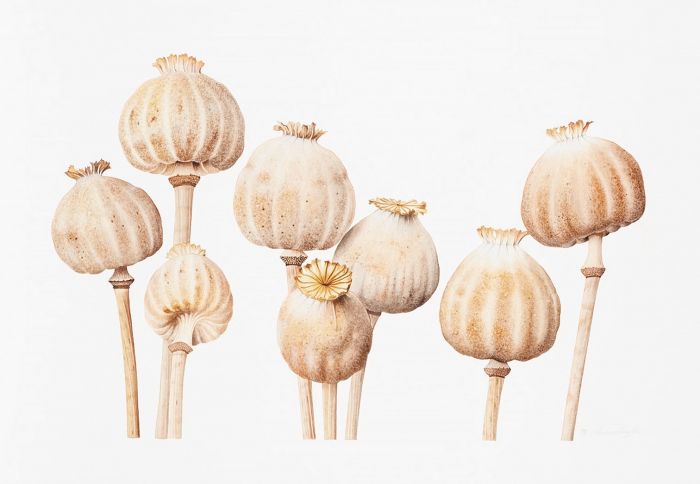Why paint the Gymea lily?
The first time I saw Doryanthes excelsa (or Gymea lily) was on a field trip for uni in the Royal National Park, and it was just extraordinary. They were like these giants. Like dinosaur plants. Their scale is so impressive. I’ve always been interested in native plants, and I thought the Gymea lily on a dark background would look striking. I wanted to challenge myself, and take it up a notch – make a big visual impact.
How does your artwork reflect the Botanica theme?
The theme in 2017 was “In sickness and in health” and it prompted me to learn more about the medicinal qualities of our native flora, and how Aboriginal people used certain plants for healing. The pulp from the stem of the Gymea lily was used to treat bluebottle stings – and I thought, “You can’t get more Australian than that!”
How difficult was the black background?
Darker backgrounds are quite complicated to achieve. Because watercolour is transparent you need a white paper. So I painted white paper with black paint, leaving space where the lily would appear. I did the background first because that was the risky part. I didn’t want to spend 500 hours painting the Gymea lily and then ruin the background!
Why work from a live specimen?
A real plant is a 3D object you can dissect, turn, and examine on a micro scale to see how it fits together. You can’t get this from a photograph’s flat plane. You really need to do your colour matching from life as well. The Gymea lily is a protected species so I got my specimen as a cut plant from the flower markets.
What skills does a botanic artist need?
If you have an appreciation for the natural world and a very good eye for detail and accuracy, they’re the most important things. There is a lot of technical skill in the paintwork, and the drawing is complicated because it’s about the power of observation. You can’t fudge things in botanic art. If you’re doing a landscape it doesn’t matter if the mountain doesn’t look exactly the same as the one you’re looking at. With a specimen for botanic art accuracy is critical.
Why is botanic art important?
Botanic art is a wonderful tool to bring the interest in nature and botany to people. Contemporary art can be intimidating but botanic art circumvents this; everyone can relate to it. Institutions the world over employ botanic illustrators, and Sydney’s Botanic Gardens employs two artists to do the scientific work needed. New species are discovered all the time – so there’s always more work to be done.

Papaver somniferum seed pods by Annie HUGHES 590 x 380mm Watercolour





